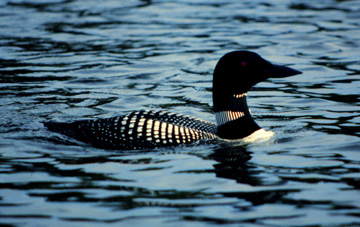Common Loon (Gavia immer)
Category: Sea Bird Other

Common Loon is a Gavia type of water bird that comes from the Gaviidae family. This bird variety is one among the biggest birds, and they are called by different names in different countries. This bird is called as the Great Northern Diver in Eurasia and the common loon in North America. These birds are swift swimmers, but they move pretty quickly in the air, as well. They are migrating type of birds and they have been clocked flying at a speed of more than 70 miles per hour. They are similar to airplanes in that they require a runway for takeoff. These birds require 30 yards areound a quarter-mile for fluttering their wings and running diagonally to the top of the water so as to gain sufficient speed for lift-off. These birds breed in Greenland, North America, Great Britain and Iceland. They winter on marine coasts or on big lakes in the United States and southern Europe, and south to northwestern parts of Africa.
Features
A well grown Common Loon bird is capable of attaining a body length ranging from 26 inches to 35.8 inches, with the wingspan ranging between 40.9 inches and 51.6 inches. Normally, they have a body mass, ranging from 88.2 pounds to 215.2 pounds.
The breeding Common Loon bird has a black color head, a checkered black-and-white color mantle and white color underparts. The plumage of the non-breeding bird is brown in color, with the white color neck and chin. The bill of this bird looks like a dagger and it is black-blue in color, which is held horizontally. The color of its bill and angle differentiate this bird variety from the analogous yellow-billed loon bird.
The Common Loon bird has a lot of solid bones, nothing like usually hollow avian bones, which append weight to their body, but assist in diving. These birds are a classic variety of the lakes of the North Woods. They are outstanding indicators of the quality of water as they need see-through lakes that make them easier for them to observe the underwater prey, with copious populations of little fish.
Usually Common Loons prefer lakes with islands and coves as they offer cover from predators while nesting and resting. They also need lakes with sufficient surface area for their fluttering-and-running takeoffs the water crossways. In the winter these birds stay along sea coasts. They are infrequently found more than numerous miles away from the shore. Some birds winter inland, on big reservoirs and slow-moving streams. The birds that travel across interior North America locate big lakes and rivers to go between on their way from north to south.
Diet
Common Loon birds are professional anglers. They feed mostly on fish, particularly sunfish and perch on their northern lagoons. If fish are inadequate or water is excessively dark for fishing, they will feed on crustaceans, leeches, snails and even the larvae of marine insects.
Behavior
Common Loon birds are furtive divers, submerging devoid of a splash to grab fish. Groups and pairs habitually call to each other during the night time. They are capable of catching fish as deep as 200 feet in the water, and they can stay underwater for as long as three minutes.
The average lifespan of the Common Loon water bird ranges from 15 years to 30 years.

 Back To Category Sea Bird Other
Back To Category Sea Bird Other